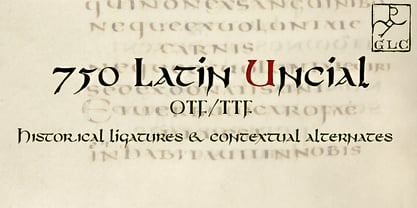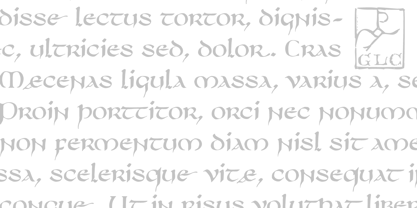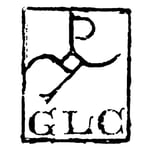Seleccione este tipo de licencia cuando esté desarrollando una aplicación app para iOS, Android o Windows Phone, y vaya a incrustar el archivo en el código de su aplicación móvil. va a incrustar el archivo fuente en el código de su aplicación móvil.
750 Latin Uncial
por GLC

Sobre la familia 750 Latin Uncial Fuente
Este fuente se inspira en la escritura latina utilizada en los monasterios europeos entre los siglos V y VIII, antes de la "Carolina" carolingia (véase nuestro Karolus 825). Era una escritura regular, redondeada, de escritura lenta, utilizada sobre todo para libros especialmente minuciosos, con algunas ligaduras, legible, pero sólo con minúsculas. Las mayúsculas consistían en minúsculas ampliadas, pero aquí hemos preferido utilizar dos modelos ligeramente diferentes. Nuestras minúsculas son una síntesis de muchas variantes (principalmente de la "Primera Biblia" de Carlos El Calvo), las mayúsculas se inspiraron principalmente en un manuscrito del año 700 de la abadía de Fécamp (Francia). Hemos adaptado la fuente para los usuarios contemporáneos, diferenciando entre U y V, I y J, lo que no tiene relevancia para los antiguos escribas latinos, y naturalmente con la puntuación Thorn, Oslash, Lslash, K, W... y los caracteres acentuados habituales que no existían en la época. Puede utilizarse con el 799 Título insular.
Diseñadores: Gilles Le Corre
Editorial: GLC
Fundición: GLC
Propietario del diseño: GLC
MyFonts debut: 9 de junio de 2010

Acerca de GLC
Gilles Le Corre nació en 1950 en Nantes, Francia. Pintor desde finales de los años 70, también es grabador y calígrafo. Conoce el arte medieval y los libros antiguos desde que tiene uso de razón. Más recientemente ha hecho del ordenador una herramienta para escribir como la pluma y la tinta. Con él, pretende hacer posible la impresión de libros con el mismo aspecto que los antiguos. Desde 2007 intenta reproducir con gran exactitud una amplia gama de tipos de letra históricos europeos, sobre todo medievales y de las primeras épocas de la imprenta -su periodo favorito-, desde 1456 con Gutenberg, hasta 1913 con una fuente inspirada en una máquina de escribir antigua de verdad.
Seguir leyendo
Leer menos